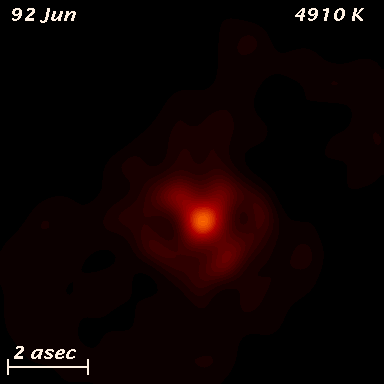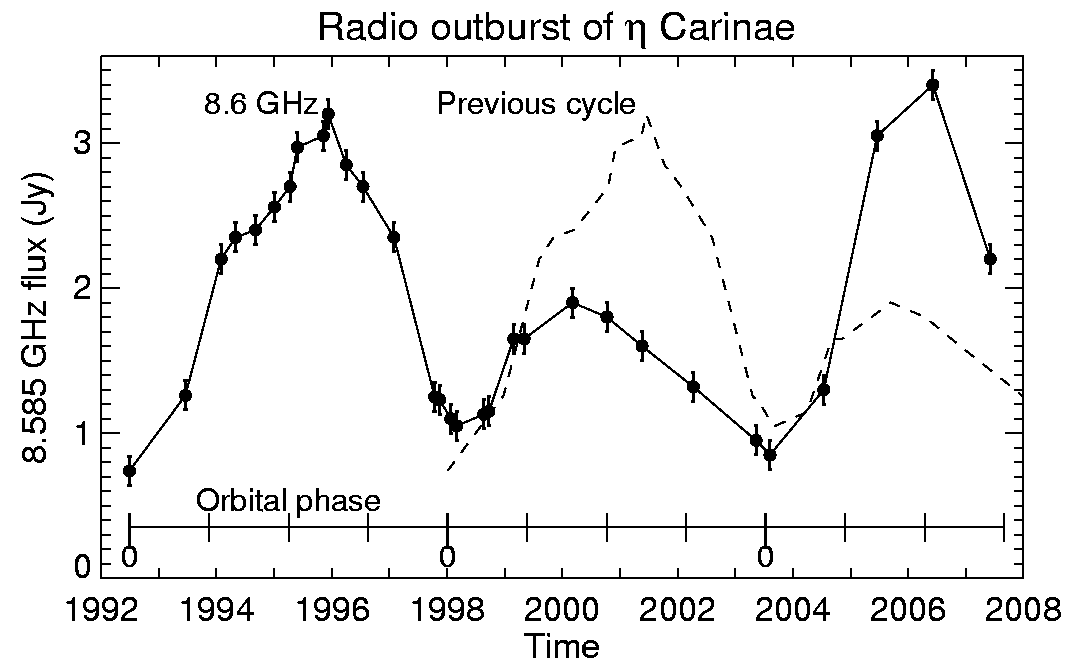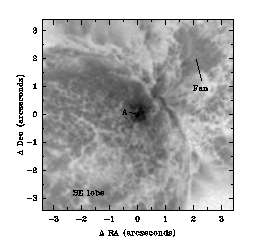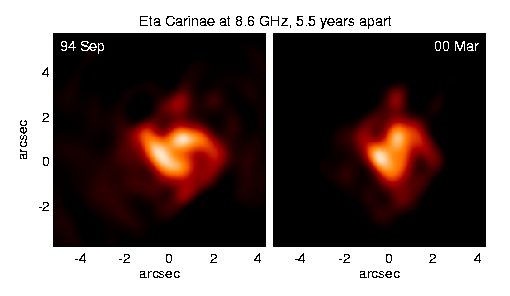

 |
The movie shows the changes in the spatial distribution of the radio emission from Eta Carinae with time. It shows images every two months simulated using images from 28 different epochs from June 1992 to June 2007, with a spatial resolution of order 0.3 arcseconds. The light curve above shows the spacing of the actual images; note that we have significant gaps between June 1992 and June 1993, and in more recent years images are obtained at a rate of just once per year. The number in the top right corner of the movie shows the peak brightness temperature in the high-resolution images; this should be about 10000 K for photoionized gas. The flux of 3.4 Jy at 8.6 GHz in June 2006, at the middle of the current cycle, is the highest value measured for Eta Carinae. We believe that the star is located at the position of the single compact peak that dominates the images at the minima in 1992, 1998, and 2003. |
 |
For comparison, this is the HST image of the core of the Homunculus nebula from the paper by Morse et al., AJ, 116, 2443 (Fig. 5) showing the apparent position of the star as well as the fan to the north-west and the orientation of the equatorial skirt. Note that the scale is not quite the same as in the radio images. |
In recent years Eta Carinae has undergone a radio outburst which makes it one of the brightest radio stars in the sky. The top figure shows how the radio flux of Eta Carinae has varied with time since 1992. In 1996 Brasilian astronomer Augusto Damineli pointed out that there seemed to be a 5.5 year cycle in the emission from Eta Carinae, which he could clearly see in a particular emission line of the element Helium at infrared wavelengths. He predicted that Eta Carinae would show dramatic changes at the end of 1997, as it had in the middle of 1992. The radio data in this figure clearly seem to show that in 1998 the radio flux returned almost (but not quite) to the level at which we saw it in 1992 (coincidentally, the first radio observation was right at the previous dip in the cycle). In a session at the January 1998 meeting of the American Astronomical Society, a number of observers showed other data confirming Damineli's prediction. Our most recent observations show the radio flux to be on the increase again, with a morphology consistent with 5.5 years ago.
The increase in radio emission has occurred because cool gas in the general outflow close to the star (i.e., within several arcseconds), which in 1992 did not show up in the radio images, has been excited by a blast of radiation. The movie shows how this excited gas is distributed on the sky and how it changes with time. All the gas visible in the radio images is closer to us than the stellar system is (we know this because we can measure the velocity of the radio-emitting gas and it is moving towards us). It is now believed that the system consists of two very massive stars, one of which is more evolved and has a powerful neutral wind, the other being a very hot star. The hot star supplies ultraviolet light which can ionize the gas in the system some distance from the star. When the gas is ionized, it produces radio emission. The effective temperature for such UV-ionized gas should be about 10000 K, as observed. However, every 5.5 years when the binary orbit causes the evolved star to pass between us and the hot star, its wind absorbs all the ultraviolet light and shuts off the supply of ionizing photons to the gas, which recombines (becomes neutral again) and thus ceases to emit radio waves. As the evolved star moves further on its orbit, the hot star is revealed once again and the process starts all over. Thus the variation in the radio flux is due to a lighthouse effect, in which the evolved star with the strong wind controls the supply of ultraviolet photons from the hot star.
 |
We are now into our second cycle of observing Eta Car, and as the top figure shows, the radio behaviour is not repeating exactly as in the first cycle. At the time of minimum the radio flux remained higher than it was during the observation in June 1992, and since then the radio flux has not risen as rapidly as it did 5.5 years earlier. The figure above shows a comparison of the appearance of the radio emission at two epochs exactly 5.5 years apart: the newer observation (2000 March 6) shows a smaller area of radio emission overall, although the same features are present as were observed in September 1994. The hysteresis in the radio cycle is not surprising given that the radio emission is from gas ionized by UV peeking through the inhomogeneous wake of the mass-losing star in the system.
More information on the recent research on Eta Carinae can be found on the web pages of Augusto Damineli and through links in the web page of Bish Ishibashi and Kris Davidson at the University of Minnesota, including Mike Corcoran's X-ray emission page and Jon Morse's page of beautiful HST images.
This research has been supported by the National Science Foundation's International and Astronomy programs, and the unique foieign facilities travel fund administered by NRAO.